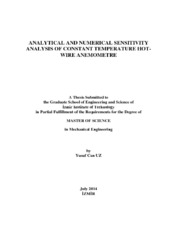Please use this identifier to cite or link to this item:
https://hdl.handle.net/11147/4179Full metadata record
| DC Field | Value | Language |
|---|---|---|
| dc.contributor.advisor | Özkol, Ünver | |
| dc.contributor.author | Uz, Yusuf Can | - |
| dc.date.accessioned | 2014-11-18T09:09:18Z | |
| dc.date.available | 2014-11-18T09:09:18Z | |
| dc.date.issued | 2014 | |
| dc.identifier.uri | http://hdl.handle.net/11147/4179 | |
| dc.description | Thesis (Master)--Izmir Institute of Technology, Mechanical Engineering, Izmir, 2014 | en_US |
| dc.description | Includes bibliographical references (leaves: 78-79) | en_US |
| dc.description | Text in English; Abstract: Turkish and English | en_US |
| dc.description | xiv, 79 leaves | en_US |
| dc.description.abstract | Hot-wire anemometry (HWA) has been used for many years as a research tool in fluid mechanics. HWA consists of a wire sensor, a very fine element exposed to the fluid flow and of an electronic system, which performs the transformation of the sensor output into a useful electric signal. HWA is based on convective heat transfer from a heated wire which is placed into a fluid flow. The heat is generated inside the very fine wire owing to wire resistance when electrical current passes through it. Then, the wire will be subjected to heat losses by convection, conduction and radiation depending on the flow condition. To examine the theory of operation for the heated wire and plot the temperature distribution along it, energy balance for HWA is investigated by taking differential element of dx length of the filament. In order to understand static and dynamic characteristics of hot-wire, all kinds of heat transfer such as convection, conduction and radiation are taken into consideration. In present thesis, the static study starts to investigate influence of the sensor parameters on general behavior of the constant temperature hot-wire anemometer analytically and numerically at varying conditions. Most important part of this study is that the time dependent differential equation for the heated wire is solved to determine sensitivity of hot-wire by a perturbation method in the event of a harmonically changing heat transfer coefficient. Moreover, the influence of thin supporting wires, or copper plated wire ends, is evaluated to see the effects of them on sensitivity and heat dissipation to the prongs. Another important parameter for wire sensor is the aspect ratio (L/d). Aspect ratio affects the time constant, sensitivity and temperature distribution of heated wire; hence it needs to be examined. Also, effect of the various velocities on the temperature distribution and sensitivity along the hot-wire has been studied. | en_US |
| dc.language.iso | en | en_US |
| dc.publisher | Izmir Institute of Technology | en_US |
| dc.rights | info:eu-repo/semantics/openAccess | en_US |
| dc.subject.lcsh | Hot-wire anemometer | en_US |
| dc.subject.lcsh | Fluid dynamic measurements | en_US |
| dc.subject.lcsh | Heat--Transmission--Measurement | en_US |
| dc.title | Analytical and numerical sensitivity analysis of constant temperature hot-wire anemometre | en_US |
| dc.title.alternative | Sabit sıcaklık sıcak tel anemometre hassasiyetinin analitik ve nümerik analizi | en_US |
| dc.type | Master Thesis | en_US |
| dc.authorid | TR191337 | en_US |
| dc.institutionauthor | Uz, Yusuf Can | - |
| dc.department | Thesis (Master)--İzmir Institute of Technology, Mechanical Engineering | en_US |
| dc.relation.publicationcategory | Tez | en_US |
| item.grantfulltext | open | - |
| item.openairetype | Master Thesis | - |
| item.fulltext | With Fulltext | - |
| item.cerifentitytype | Publications | - |
| item.openairecristype | http://purl.org/coar/resource_type/c_18cf | - |
| item.languageiso639-1 | en | - |
| Appears in Collections: | Master Degree / Yüksek Lisans Tezleri | |
Files in This Item:
| File | Description | Size | Format | |
|---|---|---|---|---|
| 10013295.pdf | MasterThesis | 2.48 MB | Adobe PDF |  View/Open |
CORE Recommender
Page view(s)
178
checked on Jul 15, 2024
Download(s)
122
checked on Jul 15, 2024
Google ScholarTM
Check
Items in GCRIS Repository are protected by copyright, with all rights reserved, unless otherwise indicated.